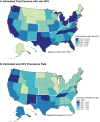Estimation of State-Level Prevalence of Hepatitis C Virus Infection, US States and District of Columbia, 2010
- PMID: 28449115
- PMCID: PMC5434341
- DOI: 10.1093/cid/cix202
Estimation of State-Level Prevalence of Hepatitis C Virus Infection, US States and District of Columbia, 2010
Erratum in
-
Erratum.Clin Infect Dis. 2017 Oct 15;65(8):1431-1433. doi: 10.1093/cid/cix563. Clin Infect Dis. 2017. PMID: 29017252 Free PMC article. No abstract available.
Abstract
Background.: Hepatitis C virus (HCV) infection is the most common chronic blood-borne infection in the United States and a leading cause of morbidity and mortality. Previous analyses of the US National Health and Nutrition Examination Survey (NHANES) indicated approximately 3.6 million noninstitutionalized persons with antibody to HCV (anti-HCV). However, state-level prevalence remains less understood and cannot be estimated reliably from NHANES alone.
Methods.: We used 3 publicly available government data sources to estimate anti-HCV prevalence in each US state among noninstitutionalized persons aged ≥18 years. A small-area estimation model combined indirect standardization of NHANES-based prevalence with logistic regression modeling of mortality data, listing acute or chronic HCV infection as a cause of death, from the National Vital Statistics System during 1999-2012. Model results were combined with US Census population sizes to estimate total number and prevalence of persons with antibody to HCV in 2010.
Results.: National anti-HCV prevalence was 1.67% (95% confidence interval [CI], 1.53-1.90), or 3 911 800 (95% CI, 3 589 400- 4 447 500) adults in 2010. State-specific prevalence ranged from 0.71% (Illinois) to 3.34% (Oklahoma). The West census region had the highest region-specific prevalence (2.14% [95% CI, 1.96-2.48]); 10 of 13 states had rates above the national average. The South had the highest number of persons with anti-HCV (n = 1561600 [95% CI, 1 427 700-1 768 900]). The Midwest had the lowest region-specific prevalence (1.14% [95% CI, 1.04%-1.30%]).
Conclusions.: States in the US West and South have been most impacted by hepatitis C. Estimates of HCV infection burden are essential to guide policy and programs to optimally prevent, detect, and cure infection.
Keywords: National Health and Nutrition Examination Survey; National Vital Statistics System.; hepatitis C; prevalence; surveillance.
© The Author 2017. Published by Oxford University Press for the Infectious Diseases Society of America.
Figures



References
-
- Ditah I, Ditah F, Devaki P, et al. The changing epidemiology of hepatitis C virus infection in the United States: National Health and Nutrition Examination Survey 2001 through 2010. J Hepatol 2014; 60:691–8. - PubMed
-
- US Department of Health and Human Services National Digestive Diseases Information Clearinghouse. Liver Transplantation Available at: http://www.niddk.nih.gov/health-information/health-topics/liver-disease/... Accessed 10 February 2017.
-
- Ly KN, Xing J, Klevens RM, Jiles RB, Ward JW, Holmberg SD. The increasing burden of mortality from viral hepatitis in the United States between 1999 and 2007. Ann Intern Med 2012; 156:271–8. - PubMed
-
- Mahajan R, Xing J, Liu SJ, et al. Mortality among persons in care with hepatitis C virus infection: the Chronic Hepatitis Cohort Study (CHeCS), 2006–2010. Clin Infect Dis 2014; 58:1055–61. - PubMed
MeSH terms
Substances
LinkOut - more resources
Full Text Sources
Other Literature Sources
Medical

